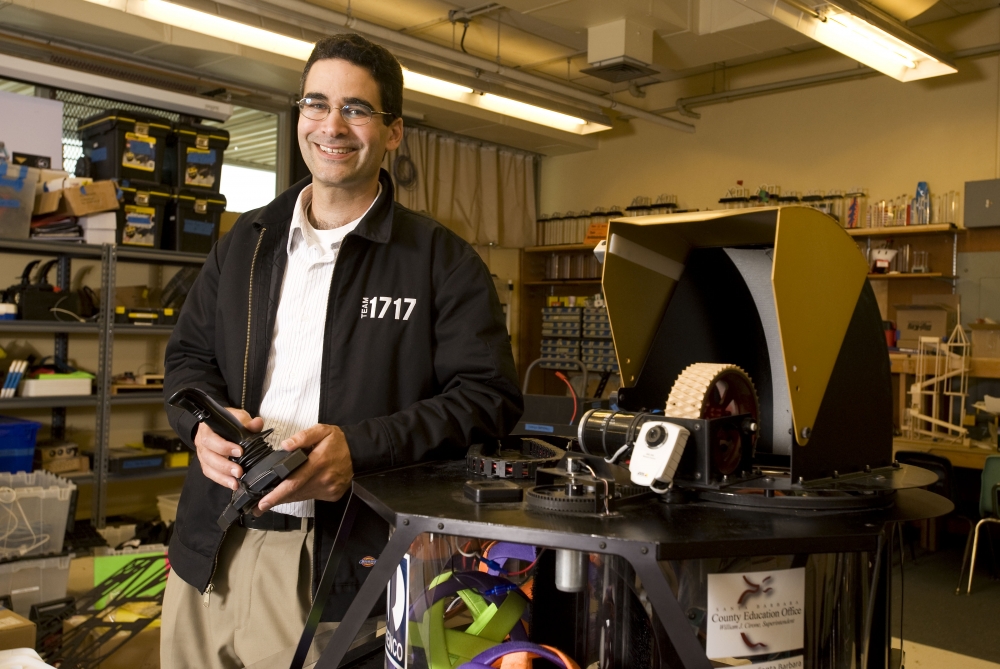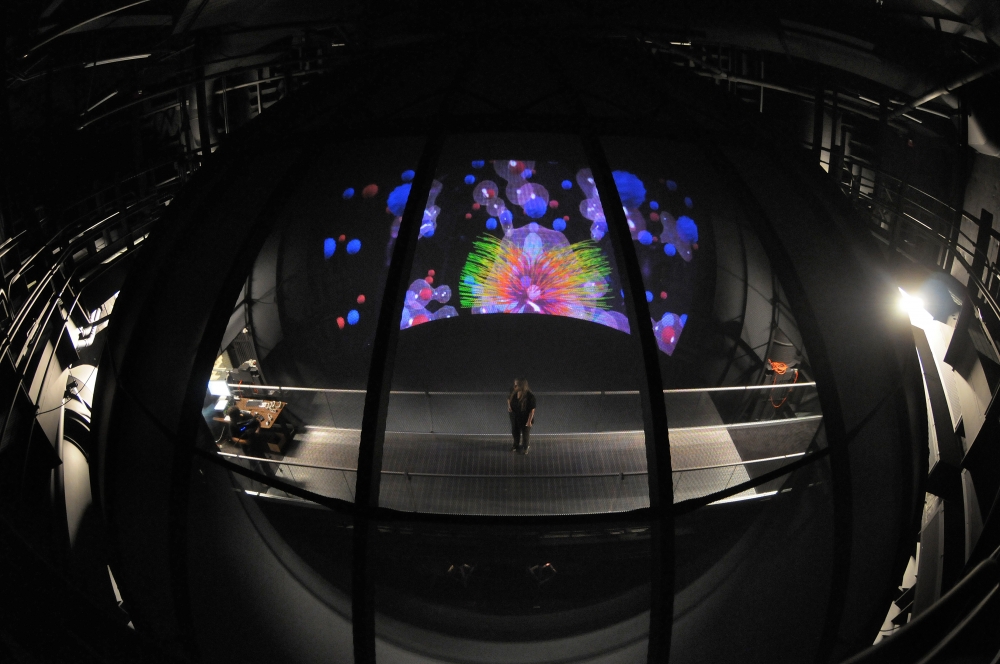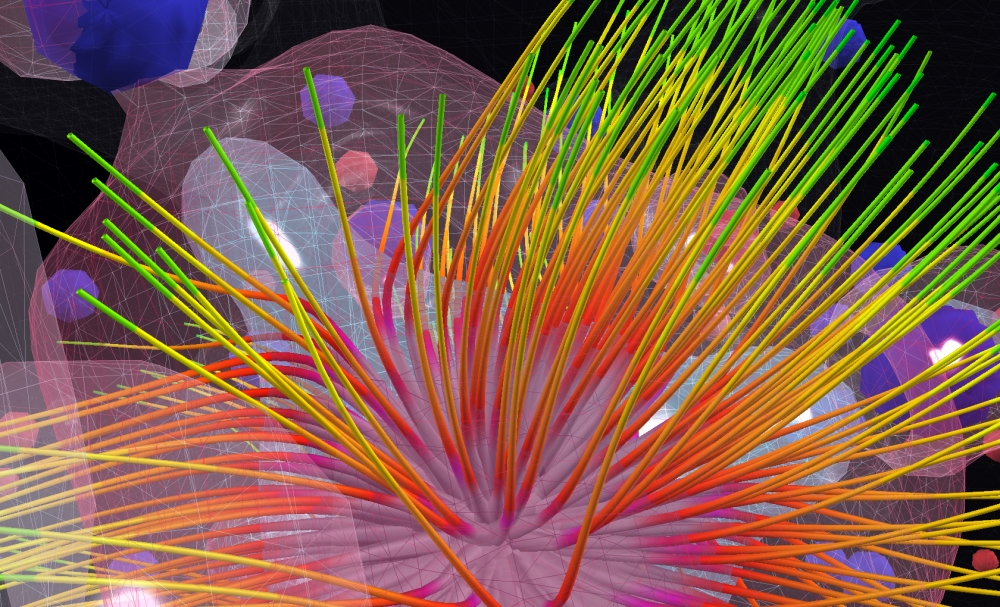Engineering a New Model for Education
The whir of activity is frenetic: hurried movements, humming machines, voices amplified in fits and spurts to match. Amid it all, a sculpture is slowly taking shape.
A mass of moving metal parts, the kinetic piece in process is a feat of both engineering and of art. And that’s the whole point.
The to-be installation is the inaugural capstone project for seniors at Dos Pueblos Engineering Academy (DPEA), where an emerging focus on the art and design involved in engineering is hitting new heights in a unique collaboration with UC Santa Barbara’s Media Arts and Technology (MAT) graduate program.
This new partnership between the academy, MAT and UCSB’s AlloSphere Research Facility is providing the high schoolers with hands-on mentorship for their yearlong endeavor in the diverse pursuit known as mechatronics. And it’s giving the graduate students direct experience in teaching and curriculum development — another key facet of the effort that also aims to bridge the gap between secondary and graduate-level education in engineering, art and design.
The nascent initiative is being generously funded by the Santa Barbara-based Mosher Foundation, which supports nonprofit education, healthcare and performing arts institutions in the region.
“We really try to focus our funding on what we call ‘make a difference’ programs to help organizations and institutions do things outside the box — things that in their world can make that difference,” said Edward Birch, the foundation’s president and a former vice chancellor at UCSB. “Our hope with this particular project was to bring together the best and the brightest of the university in this area with the best and the brightest in secondary school in ways that inspire everyone. We’ve been familiar with the AlloSphere and the innovative things that MAT is doing. DPEA is in that same category.
“What has evolved is a partnership that we’re really proud of,” Birch continued. “We put the funding directly with those who love to teach and kids who love to learn, who are bright and engaged, in a learning environment that’s terrifically encouraging. It’s wonderful. And we’re very hopeful that this will be a replicable program that can be used at other academies to become actively engaged with the university.”
Ditto for JoAnn Kuchera-Morin, founder and director of the AlloSphere Research Facility, who characterized education reform as something of a brass ring. Especially reform that emphasizes art and design as core elements of science, technology, engineering and mathematics.
“There are very high-level, applied mathematical principles in drawing shape and form — they all have equations hooked to them,” said Kuchera-Morin, who is also a professor of media arts and technology and of music. “And whether you’re building a computer system, a building, or an art piece, you have to first design it. These are ideas of structure, of shape and of form, and it is these principles, I believe, that the arts bring in. When you make a piece of music or visual artwork you’re building a system that unfolds in space and/or time and it’s all mathematics.
“Design and arts are very important aspects to the educational mission of our society,” she added. “I am very grateful that the Mosher Foundation sees the potential of what could be, and that they are willing to step up to the plate. Support like this is so important. They’ve started something great.”
This re-envisioned educational mission is already thriving and growing at DPEA, where the senior design project is a new addition, but a belief in the importance of such skills is the bedrock. Founded by UCSB triple alumnus (bachelor’s and two master’s degrees) Amir Abo-Shaeer, the academy’s curriculum blends physics, engineering and mathematics — and now, arts and design — to offer high-level learning experiences that students elsewhere may not get until graduate school.
“We should be able to figure out, at high school and university levels, how to give students a rich design experience, because that’s what they’ll have to do when they finish their education,” said Abo-Shaeer, who in 2010 became the first high school teacher to be named a MacArthur Fellow. “All folks that end up going into the world of work engage in design-based experiences for their jobs. You’re getting an open-ended set of constraints and you have to make things work together — that’s design.
“So it’s a really powerful experience for students to be able to sit down with someone who is super knowledgeable, like the UCSB graduate students, someone who has done all these things and can take you through whole design process,” Abo-Shaeer added. “If mentored properly the student has full ownership of that design, understands what that process looks like and can hit the ground more effectively when they go into their career.”
Kaycie Landis is seeing firsthand the major impact of such mentoring — and her career may just involve engineering as a result. The DPEA senior said her vision for the future is coming into sharper focus since joining the academy, where she is learning everything from machining to CAD (computer-aided design) on top of physics, math and more.
“Without our UCSB mentors I don’t know if we’d be able to do what we’re doing,” Landis said. “I’m working on a steam engine right now. It’s so complicated. So it’s really helpful to have someone show us, step by step, what to do. And to see how much they enjoy it. They give up their time to work with us because they love what they do — and you can tell that when they’re here with us. It’s really great. And it has definitely influenced my decision to be an engineering major, and hopefully an engineer.”
Whether these students go into engineering, art, computer programming, teaching or grant-writing or marketing, the hands-on experience in high-level design — plus the direct exposure to world-class researchers — they are receiving through this innovative new partnership is an undeniable boon, according to UCSB MAT doctoral candidate Gustavo Rincon.
“There’s so much synergy going on,” said Rincon, who mentors at DPEA weekly. “If we can figure out, with UCSB, DPEA and the Mosher Foundation, how to get young people inspired and keep them inspired, there will be a whole new beacon of creativity coming from Santa Barbara that could spread. And that’s exciting.”






